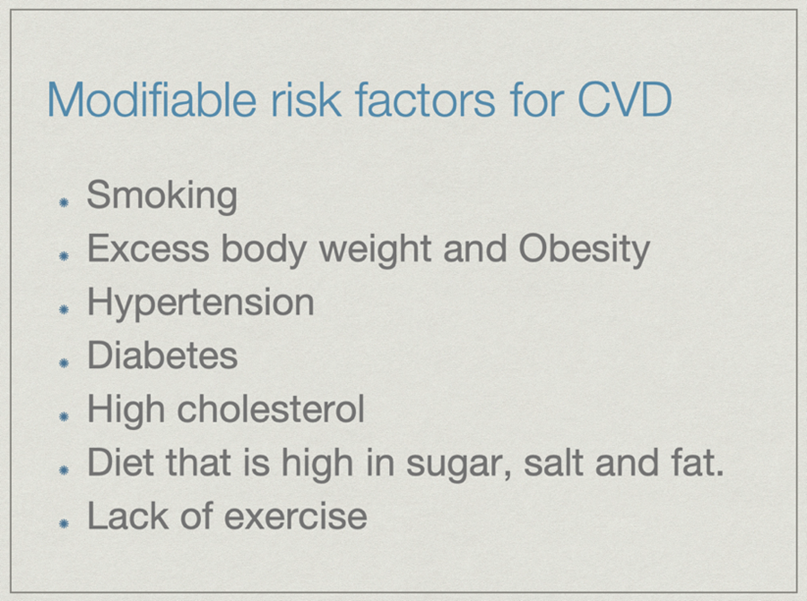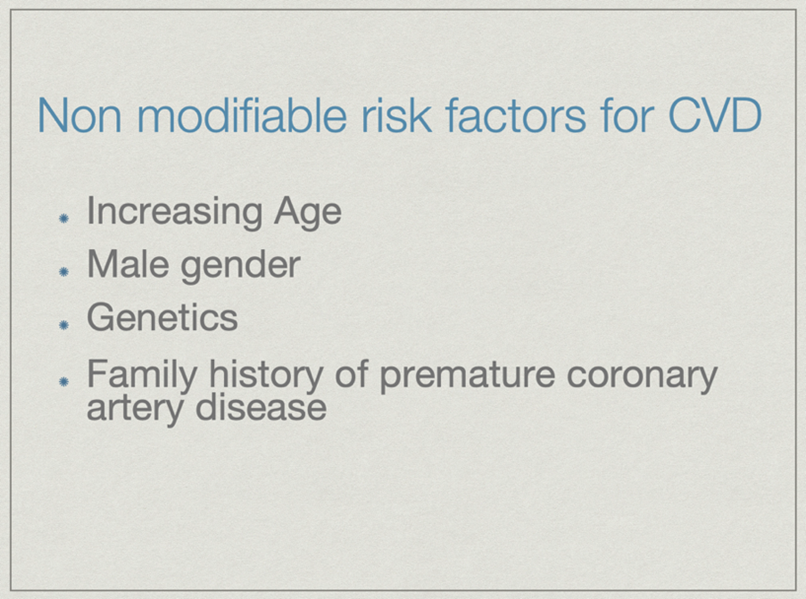Cardiovascular diseases (CVD) are a group of disorders affecting the heart and blood vessels resulting in ischemic heart disease and stroke. CVD is the leading cause of death in Malaysia and also the number one cause of death worldwide. Every year, more people die from CVD than from any other cause. In the recent data released by the Malaysia Department of Statistics, ischemic heart disease remained the principal cause of death, 15% of the 109,000 medically certified death reported in 2019. This is a staggering number when compared to other listed causes of death such as road transport accidents (3.8%) and lung cancer (2.4%).
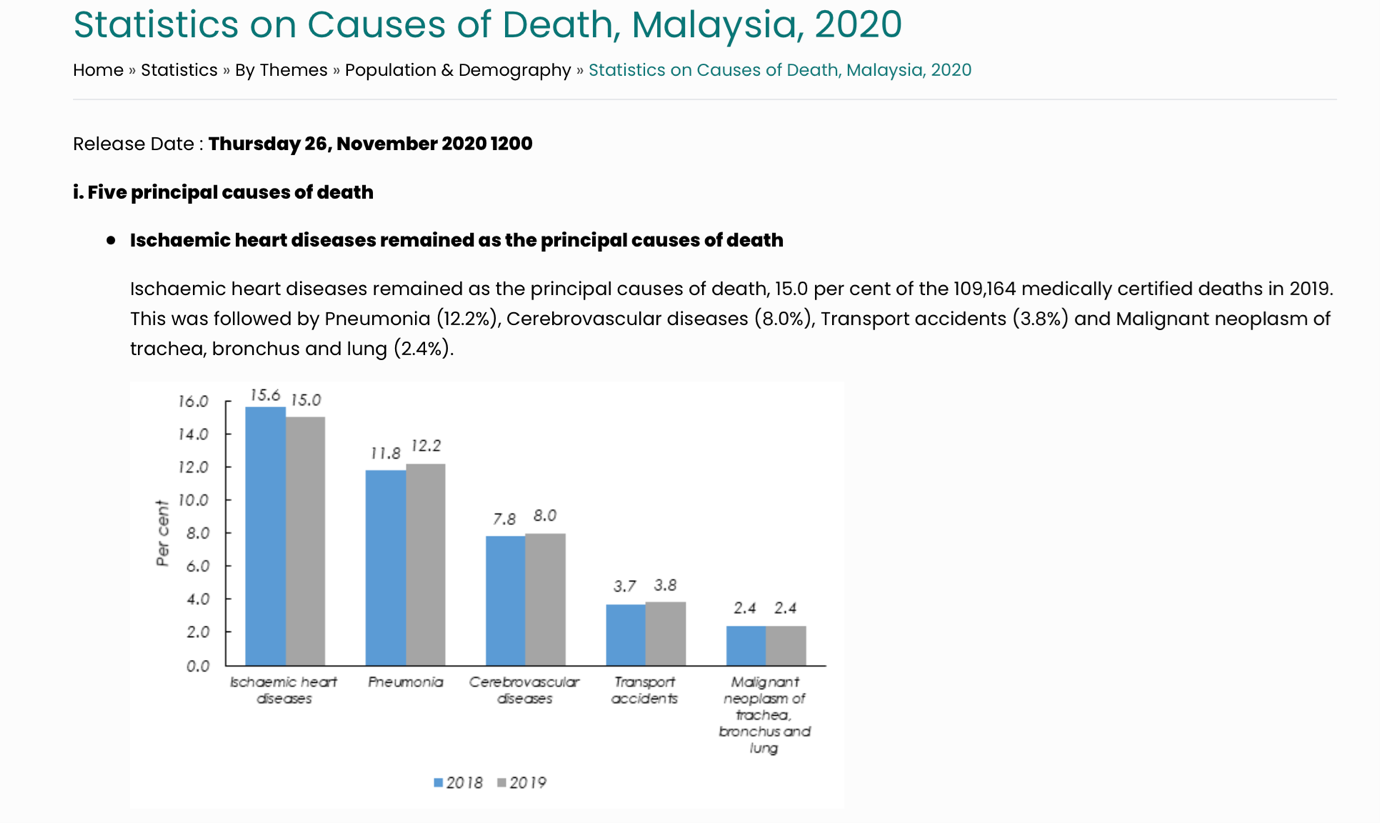
Source: dosm.gov.my
Most cardiovascular diseases can be prevented by practicing a healthy lifestyle which includes a balanced healthy diet, being physically active, maintaining healthy body weight, and avoiding harmful use of alcohol and smoking. The focus should be on prevention even though at present there are various therapeutic options available to treat cardiovascular diseases. It is crucial to equip ourselves with the knowledge of the symptoms, prevention, and treatment of cardiovascular diseases and continue to raise awareness of this number one killer in the community.
In this article, we will explore some of the important questions related to Cardiovascular diseases.
1. Hypertension or high blood pressure is one of the risk factors for cardiovascular disease. What causes high blood pressure and how to reduce it?
Hypertension is a silent disease. The only way to diagnose Hypertension is to have a doctor measure your blood pressure. Blood pressure is written as two readings. The first is a measurement of pressure when the heart is contracting (systolic) and the second represents the pressure when the heart is in relaxation, between beats (diastolic). Hypertension is when the systolic reading is more than 140 mmHg and the diastolic reading is more than 90 mmHg. High blood pressure damages the lining of the vessels and causes heart attack, stroke, and other organ damage such as kidney failure.
Many causes can lead to high blood pressure. These include lack of exercise, stress, smoking, heavy alcohol consumption, too much salt in the diet, lack of good quality sleep, being overweight, advancing age, and genetics. You can achieve good blood pressure control by being physically active, eating more fruits and vegetables, reducing salt in the diet, cessation of smoking, reducing alcohol intake, managing mental stress, ensuring good quality sleep, and losing excess body weight. It is important to routinely get your blood pressure checked and it has to be done correctly.
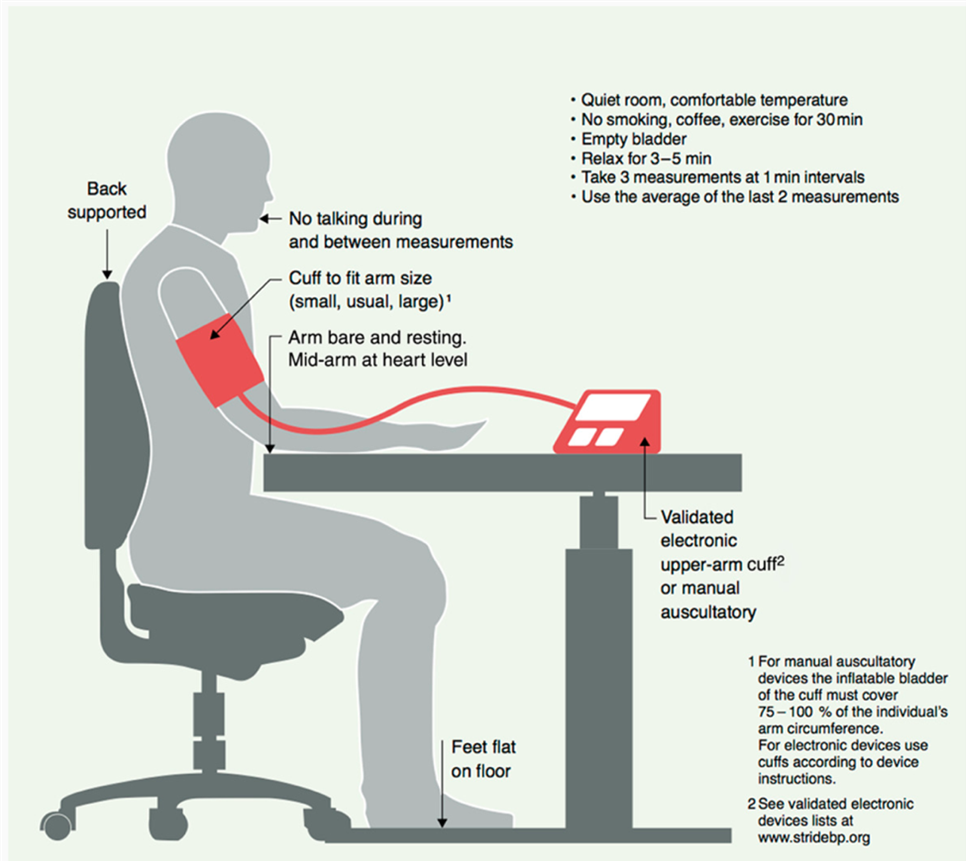
The diagram above is a recommendation on how to measure blood pressure according to 2020 International Society of Hypertension GH Practice guidelines. Hypertension 2020,75:1334-1357.
2. What are some of the most common cardiovascular diseases in Malaysia? What are the causes and contributing risk factors?
The two major cardiovascular diseases in Malaysia are ischemic heart disease and stroke. The main consequence of ischemic heart disease is a heart attack. This is a serious condition and can be fatal. This condition occurs as a result of plaque build-up inside the blood vessels (coronary arteries) supplying the heart. The plaque is usually made up of fat, cholesterol, and other substances which lead to the narrowing of the blood vessels and restrict blood flow. This condition is also called atherosclerosis. Occasionally, a plaque can rupture and a clot may form that causes interruption to blood flow and damages part of the heart muscle (heart attack). It is important to get early treatment as a delayed time of presentation to the hospital is associated with poor outcomes.
Atherosclerosis affects not just the blood vessel of the heart but also other organs such as the brain, legs, and kidneys. This will lead to other organ damage depending on which arteries are affected. Many known contributing risk factors can be divided into modifiable and non-modifiable risk factors as listed in the table below.
Modifiable & Non-modifiable risk factors for CVD
3. Cardiovascular diseases usually occur in the elderly. Can young adults have CVD too?
It is a common perception in society that cardiovascular diseases such as ischemic heart disease and stroke are seen more in the elderly group and the burden of the disease increases in the aging population. However, when compared to other populations in Europe, somehow the median age of onset of a heart attack in our population occurs in a much younger age group.
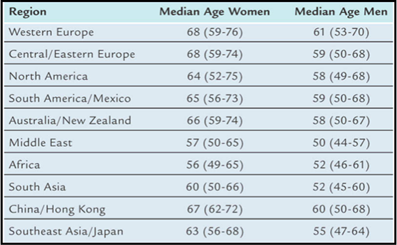
Median age of ischemic heart disease by regions
Unfortunately, there is an increasing trend of ischemic heart disease occurring in even younger individuals in our community. It is no longer a surprise for the doctors in Klang Valley to see patients as young as 30 to 35 years old presenting with chest pain that turns out to be a severe heart attack and needing immediate treatment with angioplasty (a technique to relieve the heart blood vessel blockage with balloon and stenting).
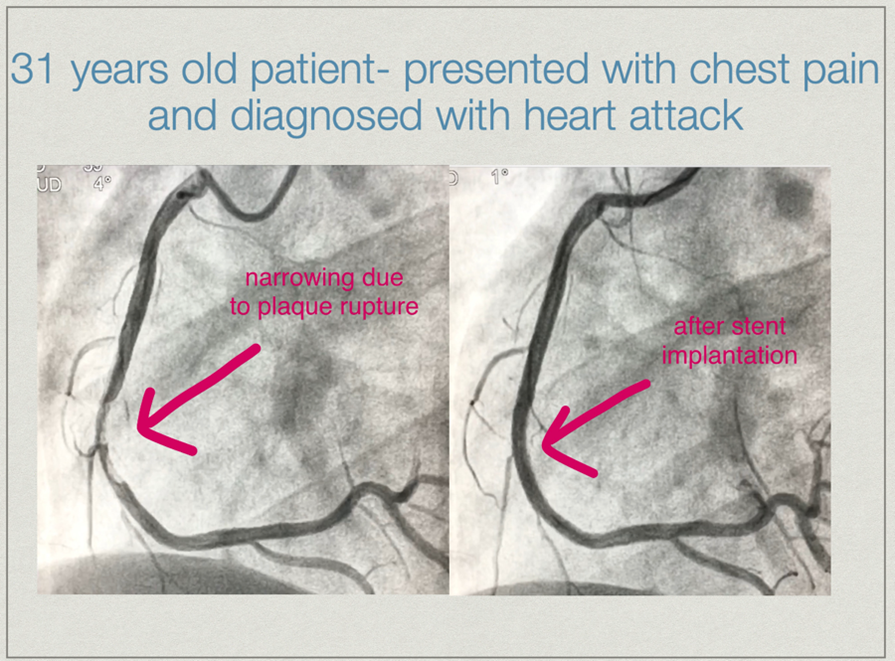
31-Year old patient presented with chest pain and diagnosed with heart attack
Most of these young
individuals have a background history of heavy smoking, strong family history
of premature coronary artery disease, undiagnosed diabetes, hypertension, and
severely elevated bad cholesterol. Therefore, you must keep check of your risk
factors for CVD even at a young age, as the more risk factors you have, the
higher the likelihood that you may develop the disease.
4. What are the signs and symptoms of cardiovascular diseases?
Ischemic heart disease may not show any symptoms or signs until
the degree of narrowing of the coronary blood vessel is severe or occluded. On
many occasions, a significant number of people do not even know that they have
the disease until they present with a medical emergency such as a heart attack.
Some, however, may experience symptoms of Angina. Angina is a sensation of
chest pain and tightness made worst with exertion and relieved by rest.
There are published data suggesting that there are slight
differences in the presentation of symptoms of a heart attack in women when
compared to men. Men often, but not always experience the classic warning signs
of chest pain, pressure, squeezing, aching sensation, and tightness in the center
of the chest. The chest pain may spread to the shoulders, neck, and arm. Some
may experience associated shortness of breath, sweating, light-headedness, and
nausea. These symptoms tend to be triggered by physical exertion before the
attacks.
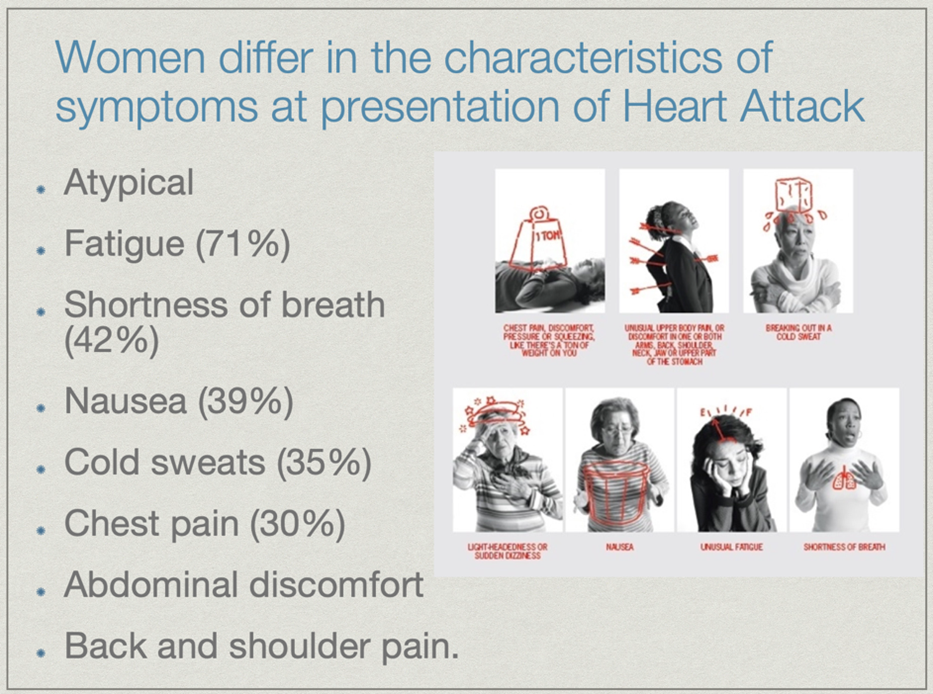
Symptoms of Heart Attack
On the other hand for women, they may also experience the classic symptoms but often milder. Only 30% of women who presented with heart attack complained of chest pain. Women may also have other symptoms like shortness of breath or breathing difficulty, nausea, vomiting, dizziness, back or jaw pain, and unexplained anxiety and weakness or fatigue. Women most often report emotional stress before heart attacks.
It is important to get yourself assessed for the risk factors of cardiovascular diseases and get your symptoms checked by your doctor early as this action can save lives.
5. How can exercise prevent cardiovascular disease? What type of exercise is best for cardiovascular disease?
Exercise undoubtedly is one of the most powerful tools for improving our health. Numerous epidemiological studies consistently show a lower risk of cardiovascular disease death in those who perform regular, moderate exercise. Even small amounts of exercise provide a significant reduction in the risk of cardiovascular disease when compared to a person who does no exercise at all.
Some of the benefits of exercise include reduction in bad cholesterol levels, improvement in blood pressure, increased insulin sensitivity, and sugar control. Regular exercise also promotes good mental health, reduces stress, and can help shed excess body weight. This practice of regular exercise when combined with healthy diet intake is the perfect combo for better health.
American Heart Association recommends that adults should do at least 30-45 minutes of moderate-intensity aerobic exercise, 3-5 times a week, preferably spread throughout the week. Aerobic exercise includes various forms such as brisk walking, jogging, cycling, swimming laps, running, hiking, or aerobic dancing like Zumba.
For a small number of individuals, who already have underlying heart conditions that are undiagnosed, exercise can sometimes be associated with the risk of sudden cardiac events or even death. It is important to get yourself checked before taking up new forms of rigorous exercise especially if you have never been previously active. This is particularly important if you are a smoker, obese, taking medications for diabetes, never had your blood pressure or blood cholesterol checked.
6. What is the best diet for cardiovascular disease? Can eating chili peppers prevent cardiovascular disease?
A balanced and healthy diet is not only going to make your body feel good but at the same time is one of the important components to help you reduce your risk of cardiovascular diseases. The American Heart Association recommends an overall healthy dietary pattern that emphasizes a variety of fruits and vegetables, whole grains, low-fat dairy products, skinless poultry, and fish. You should eat within your calorie allowance based on your age, gender, and level of physical activity. The meals should be prepared in healthy ways without adding excess sugar and salt. Limit saturated fats and trans-fat in your cooking preparation. When consuming dairy products, opt for fat-free or low-fat dairy products.
This maintenance of a balanced and healthy diet is a constant battle for all of us living in Malaysia as we are known all over the world as the food heaven. However, we should aim to make do by making adjustments to the choice of ingredients and limiting the amount of sugar and salt added to the cooking. On the day that you may have taken a higher calory intake, you should consider increasing the amount and intensity of your physical activity to burn the extra calories.
Recently there has been a hot topic on chili pepper consumption and its association with lower risk of cardiovascular death based on a published study in the JACC. This may bring out joy to the fans of spicy food lovers but to those who are sensitive to such food, please do not be disheartened. The opinion of experts on this study is that this kind of study is observational, which means it cannot prove that eating chili caused the results. It can only show an association. The participants have to report the frequency of their chili consumption and this can be a challenge to be recorded accurately it does not differentiate between the different types of chili peppers consumed.
The researchers also discovered that the group of people who ate chili more regularly, also tend to follow a traditional Mediterranean diet. This means they have a better overall diet as they eat more herbs, spices, fruits, and vegetables. Nevertheless, the key here really is to be active, eat a balanced healthy diet, and avoid harmful lifestyles such as smoking and excessive alcohol intake, as the best mode of protection against cardiovascular disease.
7. Can stress lead to cardiovascular disease?
Stress does not directly lead to plaque build-up in the vessels as described earlier in the process of atherosclerosis. However, there is sufficient evidence to show that stress is associated with a poor and unhealthy lifestyle. A stressful lifestyle and difficulties in coping may lead one to take up smoking and consuming excessive alcohol. Lack of quality sleep and a sedentary lifestyle too is common in individuals suffering from stress. The diet intake will not be healthy and all these factors will contribute to elevated blood pressure, excess body weight, poor sugar, and cholesterol control, and eventually expose oneself to cardiovascular diseases. There are plenty of organisations and institutions that provide support for individuals coping with stress. Please do not suffer alone and do reach out for help.
8. Can sudden cardiac arrest happen in people without known heart disease? What is the first aid treatment one could offer during an emergency?
Even though Sudden Cardiac Death is rare, when it happens to those who are often young and presumably fit and healthy, it has a huge emotional and social impact on the community. Sudden cardiac death is the most frequent medical cause of sudden death reported amongst athletes. In those under 35 years of age, the common cause of sudden cardiac death is inherited heart conditions such as Hypertrophic Cardiomyopathy (abnormal thickening of the heart muscle obstructing the heart pump outlet) and anomalous origin of the coronary artery (born with the abnormal course and route of coronary heart vessels). However, in those above 35 years of age, the most common cause of sudden cardiac death is due to atherosclerotic coronary artery disease and ischemic heart disease.
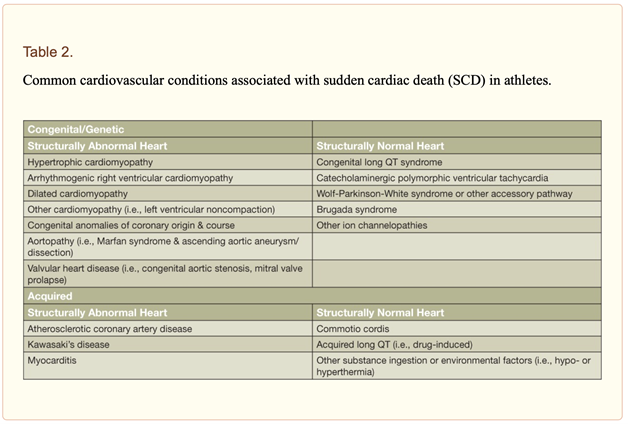
Common cardiovascular conditions associated with sudden cardiac death in athletes
When you encounter someone who has collapsed and is not responsive, immediately calls the emergency services. If you have BLS (Basic Life support) training, you may initiate the chest compressions whilst waiting for ambulance services to arrive. It is important to learn Basic Life support skills as this is lifesaving. The mantra of prevention is better than cure is so important that I hope at the end of this article, you now know most of the risk factors for cardiovascular disease and get yourselves checked for all these risk factors. Do share this with the rest of your family and loved ones. Together we encourage each other to lead a healthy lifestyle.
Written by
Datuk Dr. Akmal Hakim Arshad
Consultant Interventional Cardiologist And Cardiac MR Imaging specialist
Gleneagles Hospital Kuala Lumpur










